Imagine stepping into your backyard and instantly feeling a wave of comfort and style wash over you, thanks to the perfect outdoor seating shelter. Whether you’re a novice in the world of outdoor design or a seasoned pro, our guide, “13 Outdoor Seating Shelter Ideas for Comfort,” is your key to transforming any space into a cozy, inviting oasis. With these creative solutions, you’ll discover the joy of outdoor living that perfectly suits your lifestyle and taste.
In this guide, you’ll find a treasure trove of practical ideas that not only enhance your outdoor aesthetic but also shield you from the elements, extending your time outside. From elegant pergolas to innovative shade sails, these ideas promise to boost your confidence and inspire you to create a space that’s both functional and beautiful. Get ready to embrace the rewards of a well-designed outdoor haven, where relaxation and comfort are always within reach.
Install Retractable Awning Systems
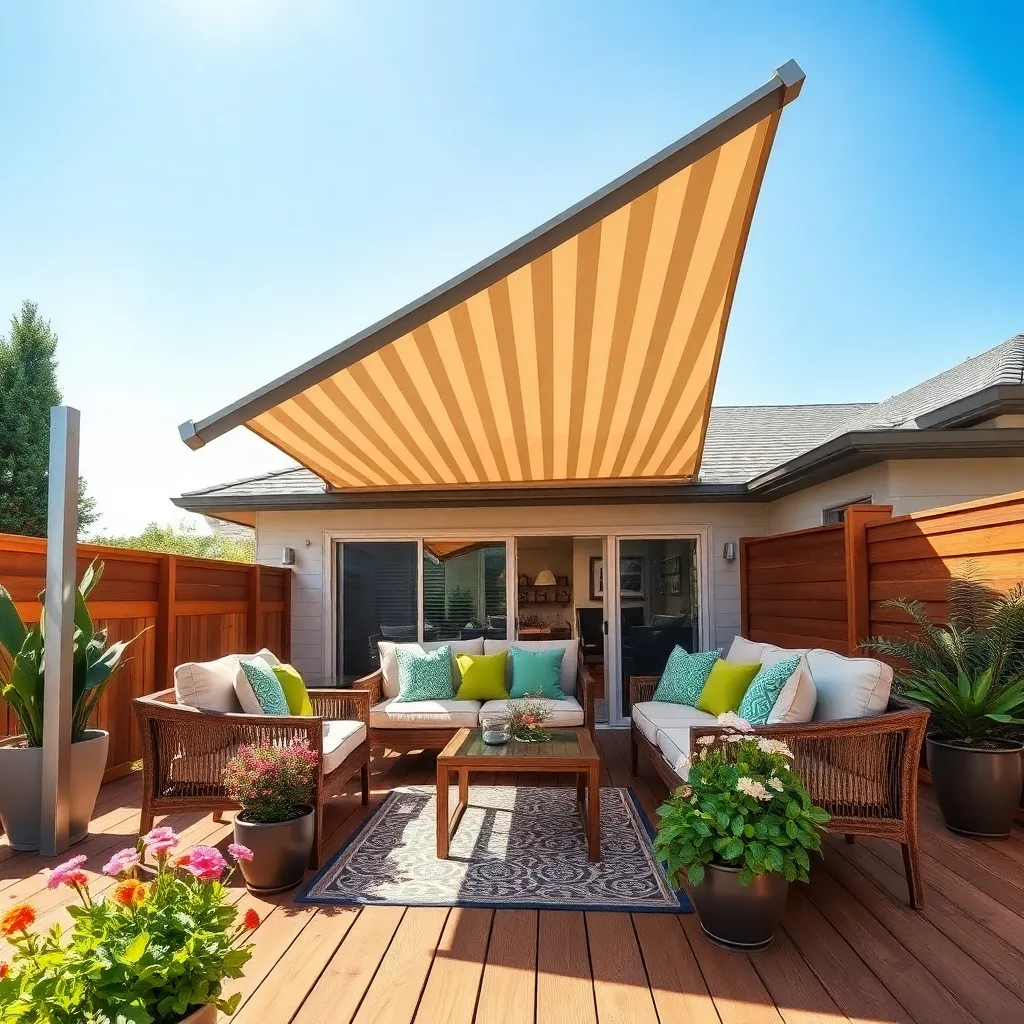
Retractable awning systems offer a versatile solution for outdoor seating areas, allowing you to enjoy shade when needed and open skies when desired. Consider using durable materials like acrylic fabric for the awning, as it offers excellent UV protection and water resistance. For beginners, ensure you measure your space accurately—typical awning projections range from 5 to 15 feet, providing ample coverage for most patios.
For a seamless installation, select a system with motorized controls for ease of use, or go for a manual crank if you’re on a budget. Advanced gardeners might explore incorporating sensors that automatically retract the awning in high winds, protecting it from damage. To enhance the aesthetic appeal, choose awning colors that complement your home’s exterior and consider adding integrated lighting for evening ambiance. An awning system not only enhances comfort but also adds a stylish touch to your outdoor space.
Incorporate Pergolas With Climbing Plants
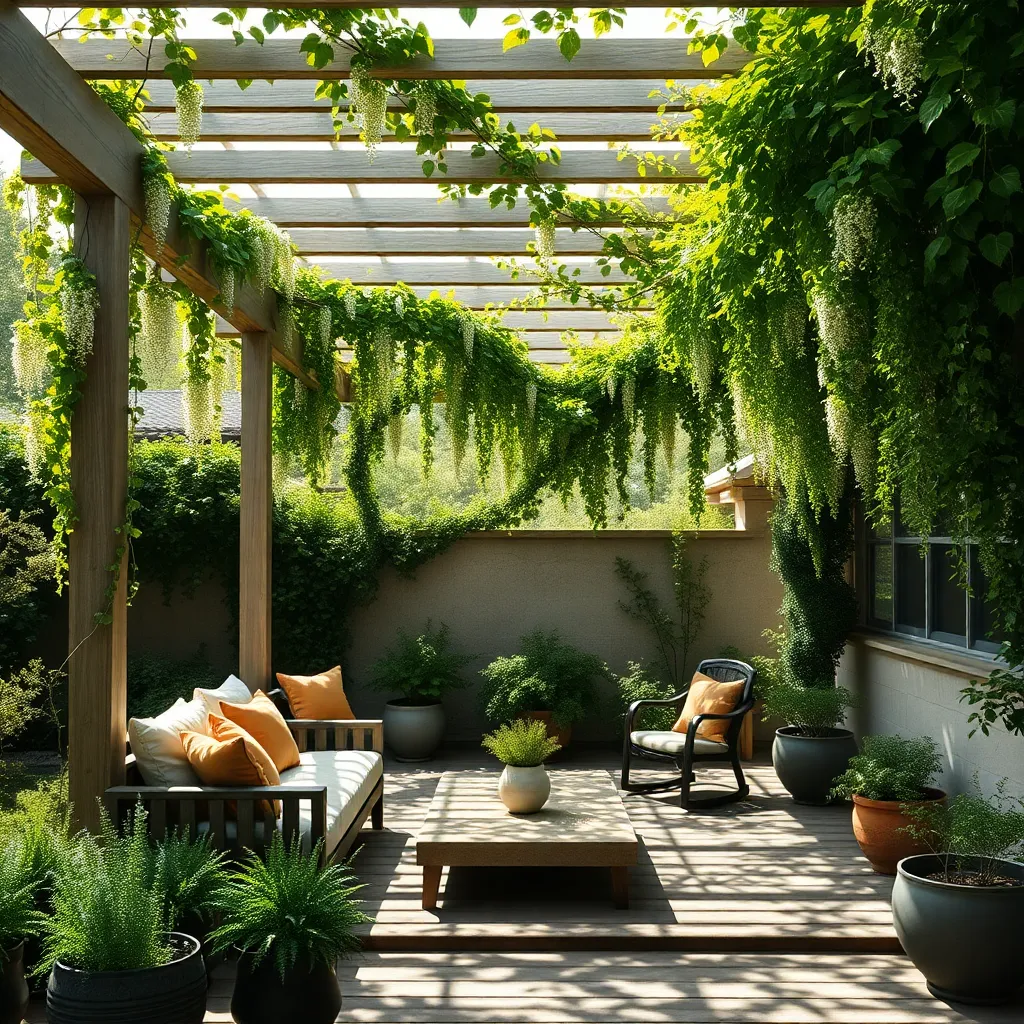
Enhancing your outdoor seating area with a pergola not only adds charm but also creates a natural canopy perfect for climbing plants. Choose materials like cedar or pressure-treated wood for durability and resistance to the elements. For beginners, start by installing a simple pergola with dimensions that complement your existing space—typically, a width of 8 feet and a height of 10 feet works well for most patios.
For a vibrant and lush look, consider planting fast-growing climbers like wisteria or jasmine. Advanced gardeners might opt for a combination of flowering and evergreen varieties to ensure year-round coverage. To encourage vertical growth, use sturdy wires or trellises attached to the pergola structure. This setup not only provides shade but also enhances privacy, making your outdoor area a cozy retreat.
Use Shade Sails for Flexibility
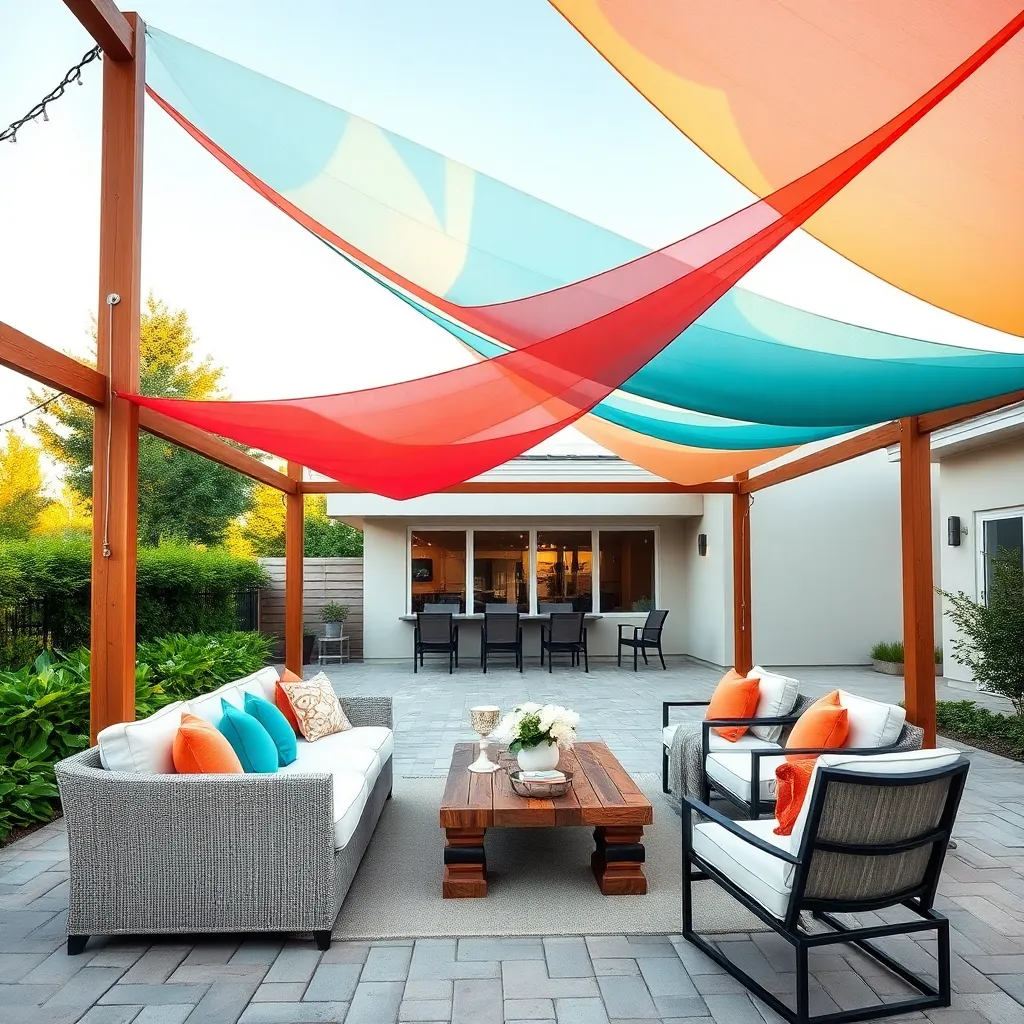
Shade sails offer a versatile and stylish solution for creating comfortable outdoor seating areas. These fabric canopies can be easily installed using durable posts, walls, or trees as anchor points, providing flexible coverage that adapts to your space. Choose UV-resistant materials like high-density polyethylene, which not only provide excellent sun protection but also allow air to circulate, keeping the area cool and pleasant. For beginners, starting with a triangular shade sail can be a manageable option, as it requires only three anchor points and is easier to tension properly.
Advanced users can experiment with layering multiple sails to create dynamic visual effects and more comprehensive coverage. Consider mixing different shapes—like squares and triangles—and colors to add visual interest and complement your garden’s aesthetic. Ensure your anchor points are strong and secure; use heavy-duty hardware like stainless steel turnbuckles and carabiners for lasting durability. To maximize flexibility, install adjustable fixtures that allow you to change the angle and height of the sails as needed, adapting to the sun’s movement throughout the day.
Add Sunbrella Fabric Canopies

Adding a Sunbrella fabric canopy to your outdoor seating area is a stylish and durable way to enhance comfort and protection. Sunbrella fabrics are known for their exceptional UV resistance and weatherproof qualities, making them an ideal choice for outdoor use. To create a custom canopy, start by measuring the area you wish to cover and select a Sunbrella fabric in a color or pattern that complements your outdoor decor. For installation, consider using a retractable frame or fixed posts, ensuring the structure can withstand various weather conditions.
Incorporating a Sunbrella canopy not only provides shade but also adds a touch of elegance to your outdoor space. For a more advanced setup, consider integrating LED lighting beneath the canopy for evening ambiance or attach side curtains for additional privacy and sun protection. Secure the fabric with marine-grade hardware to ensure longevity, and remember to clean the fabric periodically with mild soap and water to maintain its vibrant appearance. Whether you’re a beginner or seasoned gardener, these design elements offer both functionality and visual appeal, encouraging more time spent outdoors.
Set Up a Gazebo for Privacy
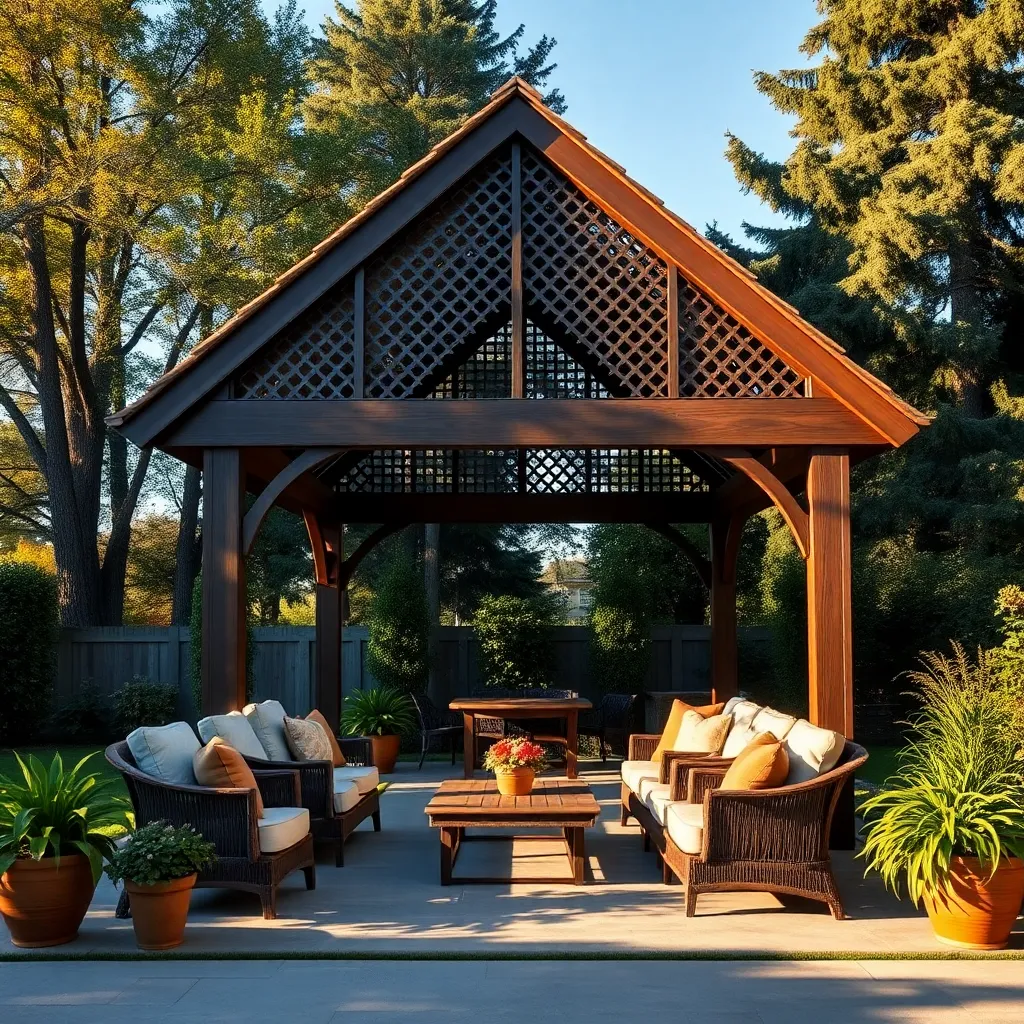
Consider setting up a gazebo to improve privacy in your outdoor space while enhancing comfort. Start by selecting a sturdy material like wood or metal for the frame, ensuring it can withstand various weather conditions. Opt for a design with enclosed sides, using materials like lattice panels or outdoor curtains for additional seclusion. For beginners, pre-fabricated kits are available and often include easy-to-follow instructions. When positioning your gazebo, place it strategically to block views from neighboring properties or public spaces.
Experienced DIY enthusiasts may want to customize their gazebos with added features. Incorporate climbing plants such as ivy or wisteria along the structure to create a natural privacy screen over time. Use weather-resistant fabrics for curtains and cushions to maintain durability and comfort throughout the seasons. For an upscale touch, consider adding decorative elements like hanging lanterns or string lights to enhance the ambiance. Finally, ensure your gazebo is securely anchored to the ground, using concrete footings or heavy-duty stakes to prevent any movement during windy conditions.
Create Shade With Tree Plantings
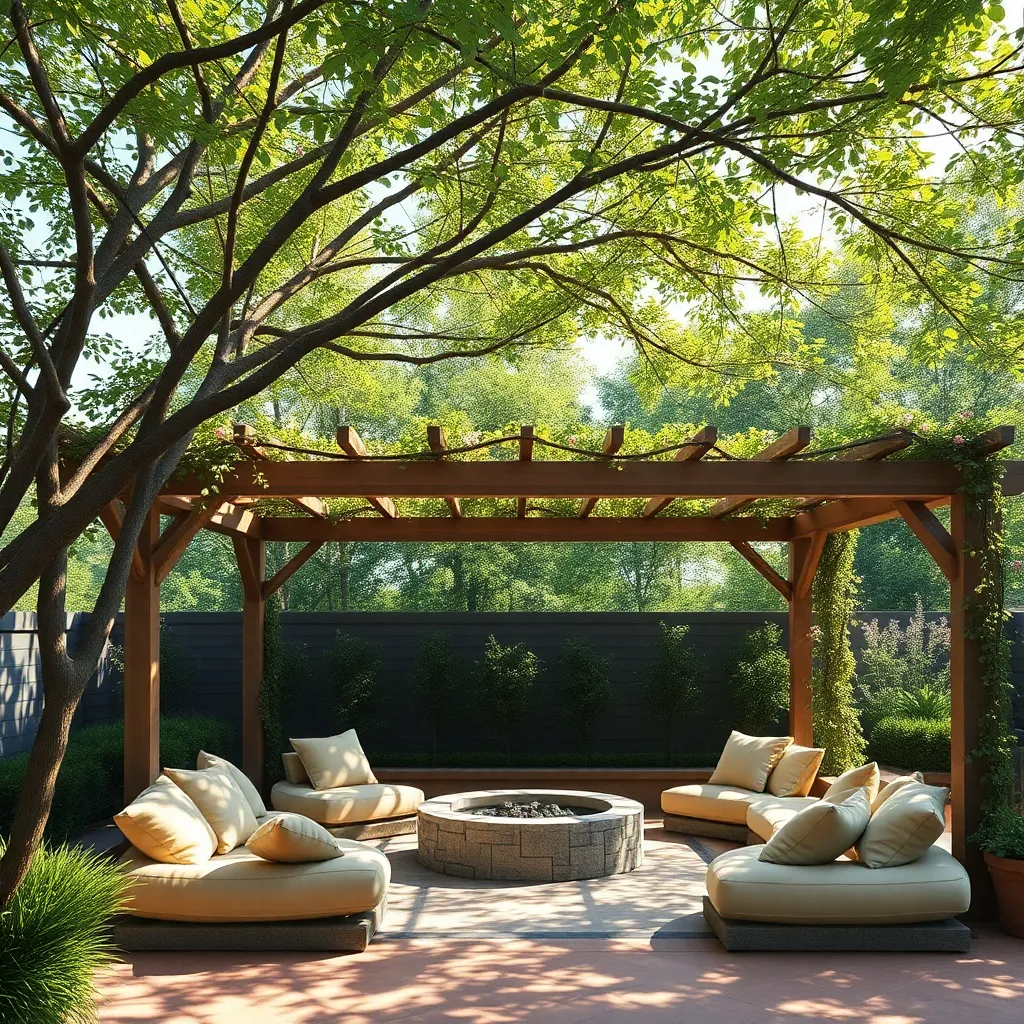
Using trees to create shade is not only a natural and environmentally friendly option, but it also adds beauty and character to your outdoor seating area. Start by identifying the size and shape of the space you want to cover. Opt for fast-growing species like the Red Maple or Sawtooth Oak for quicker results. Plant them strategically to provide optimal shade during peak sunlight hours. Consider the mature size of the trees to ensure they fit well within your landscape without overwhelming other plants or structures.
Enhance your tree planting project by incorporating a mix of deciduous and evergreen trees to provide year-round interest and varying levels of shade. For a more advanced touch, design your planting layout to include trees with different heights and canopy spreads, which can create a layered effect and increase the shaded area. Mulching around your trees will not only retain soil moisture but also reduce competition from weeds, ensuring your trees grow strong and healthy. With these thoughtful choices, your outdoor seating area will become a cool, inviting retreat that evolves beautifully over time.
Build a Roofed Pavilion Structure
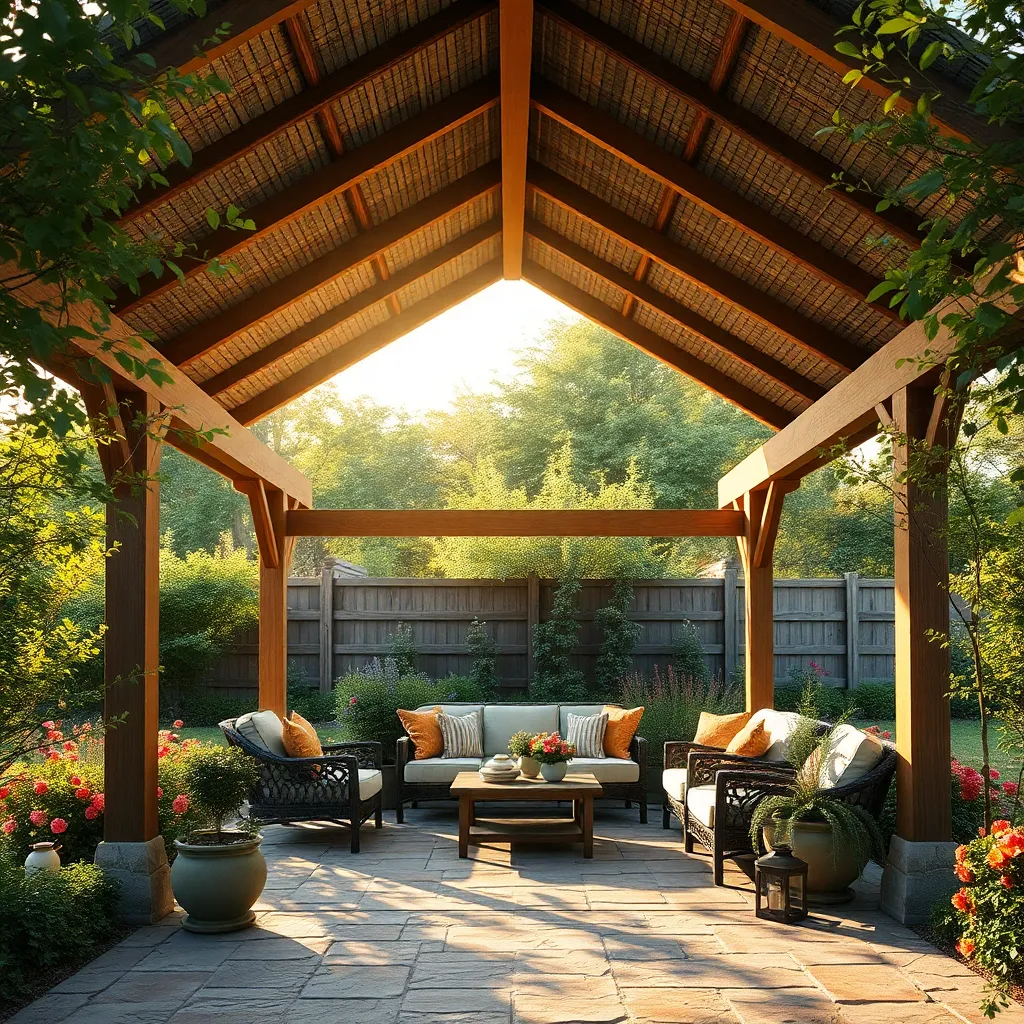
Building a roofed pavilion structure is an excellent way to create a comfortable and stylish outdoor seating area. Start by selecting a durable material for the frame, such as treated wood or metal, which can withstand the elements. For a basic design, consider a rectangular structure with a sloped roof to ensure water runoff. Beginners might opt for a simple design using pre-cut kits available at home improvement stores, while more experienced builders can customize their pavilion with unique features like built-in seating or decorative beams.
It’s important to plan the size of your pavilion according to your available space and intended use. A pavilion measuring 12×12 feet is a popular choice for accommodating a small dining set or a few lounge chairs. Cover the roof with sturdy materials like polycarbonate panels or corrugated metal sheets, both of which offer excellent protection from the sun and rain. For added comfort, consider installing a ceiling fan or string lights beneath the roof. Remember to anchor the structure securely to avoid any movement during windy conditions, using concrete footings or ground anchors for stability.
Attach Outdoor Curtains for Versatility
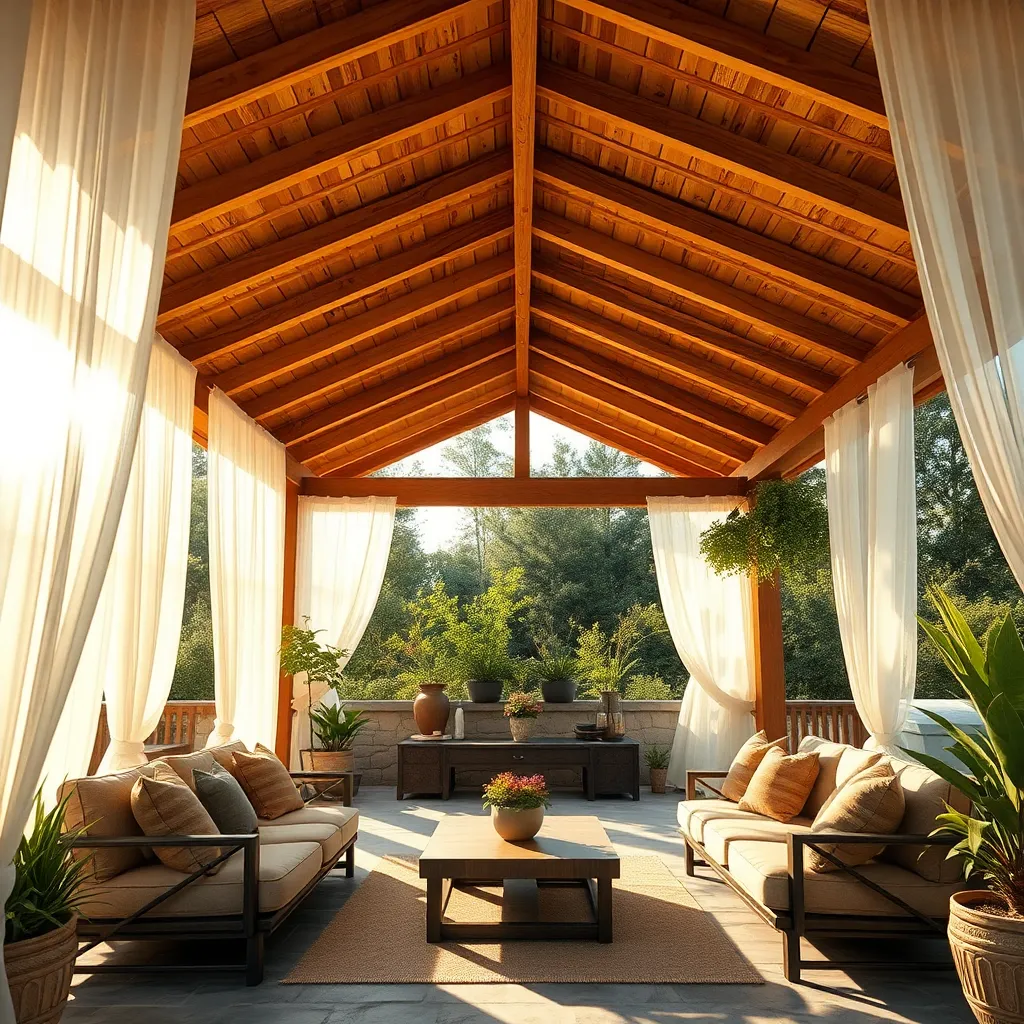
Enhance the versatility of your outdoor seating area by adding curtains to your shelter. Outdoor curtains can be both functional and stylish, providing privacy, shade, and protection from the elements. For beginners, start with weather-resistant fabrics like polyester or acrylic, which are durable and easy to maintain. Use curtain rods made of rust-resistant materials like stainless steel or aluminum to ensure longevity, especially in humid climates.
For a more advanced touch, consider incorporating tiebacks and weights to keep the curtains in place during breezy conditions. Install grommets or tab tops for easy movement and a polished look. Ensure your curtain panels are wide enough to fully cover the sides of your shelter when drawn—typically about 1.5 to 2 times the width of the opening. This simple addition can transform your outdoor space into a cozy retreat, inviting you to enjoy it all year round.
Integrate Outdoor Umbrella Stands
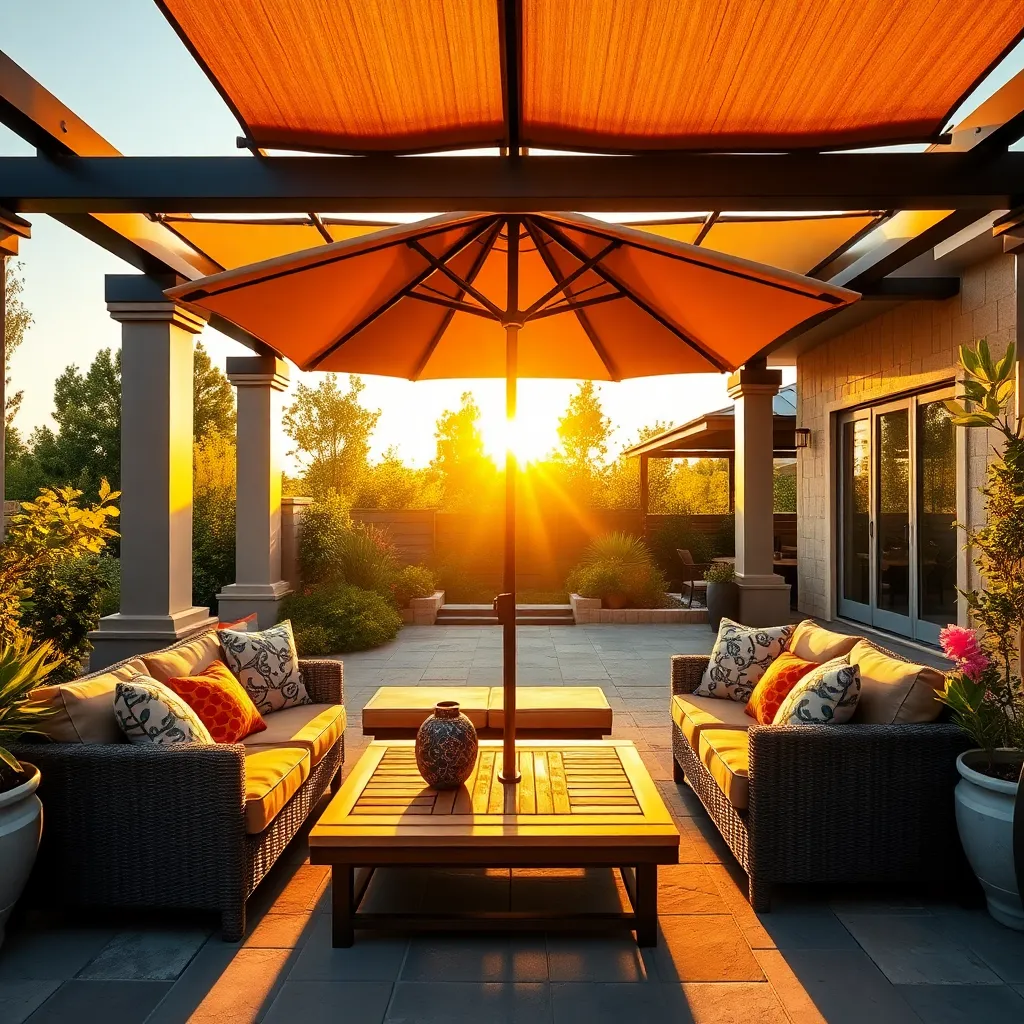
Integrating outdoor umbrella stands into your seating area is a smart way to provide shade and comfort. Start by selecting a heavy-duty, weather-resistant base to ensure stability during windy conditions. For beginners, consider stands made from materials like cast iron or concrete, which offer excellent support and durability. For a cohesive look, match the umbrella fabric with your existing outdoor décor, choosing complementary colors or patterns.
To maximize functionality, opt for an adjustable or tilting umbrella design, allowing you to adapt the shade as the sun moves. Advanced gardeners might explore built-in stands that can be integrated into a deck or patio. These designs often involve securing the stand directly into the flooring, providing a seamless and clutter-free appearance. Always ensure that your umbrella’s dimensions are proportionate to your seating area for optimal coverage and visual balance.
Construct a Wooden Arbor with Vines
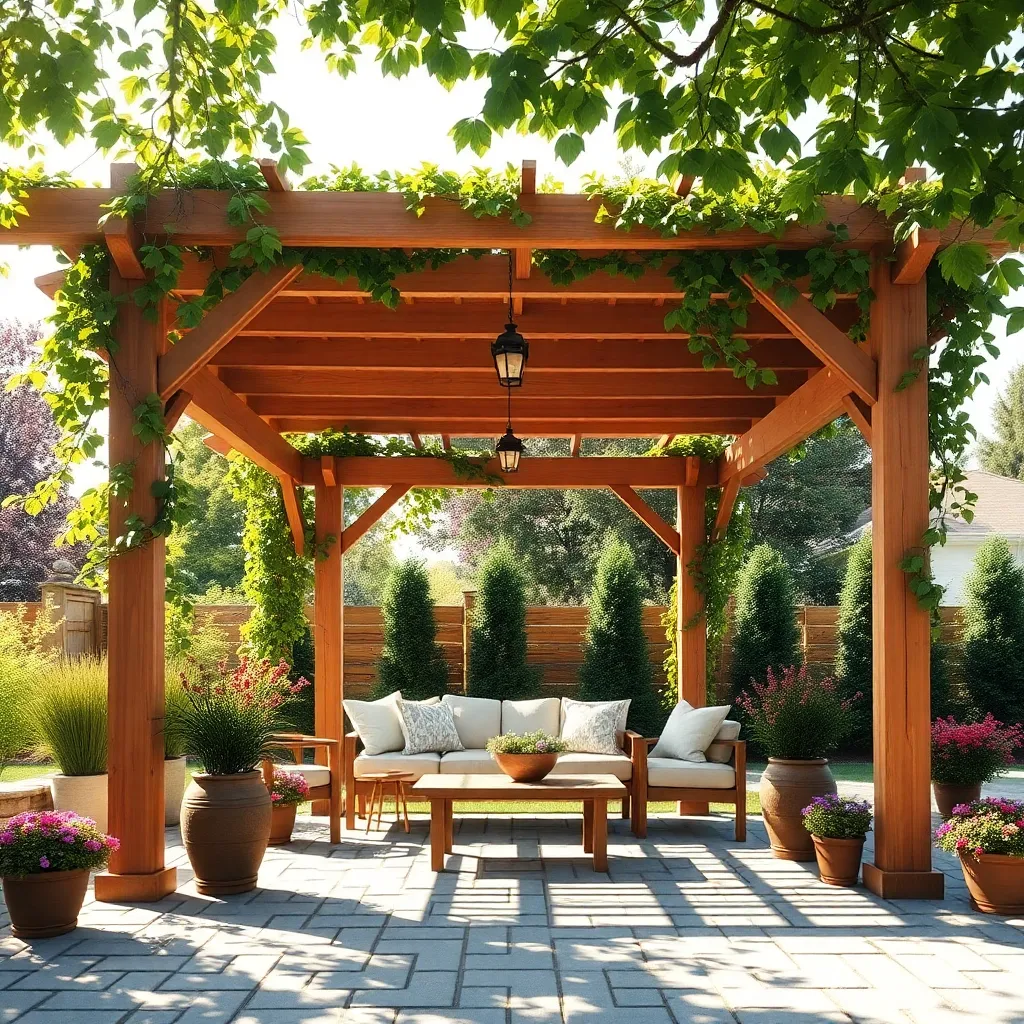
Creating a wooden arbor with vines can transform your garden into a charming retreat. Start by choosing durable wood like cedar or redwood, which resists rot and weathering. Construct the arbor to be at least 7 feet tall and 3 feet wide for comfortable passage and optimal vine growth. For beginners, a simple rectangular design with a flat top is easier to build, while experienced DIYers might consider adding ornate latticework for a more elaborate look.
To ensure your arbor supports climbing plants effectively, install horizontal beams spaced about 12 inches apart. Select fast-growing and hardy vines like clematis, wisteria, or climbing roses to quickly cover the structure and provide shade. Secure the arbor in the ground with concrete footings to withstand wind and weather. As a pro tip, treating the wood with a weatherproof sealant will enhance its longevity and maintain its appearance over time. With these steps, you’ll create a beautiful, functional shelter that enhances your outdoor seating area.
Invest in a Pop-Up Shelter Tent
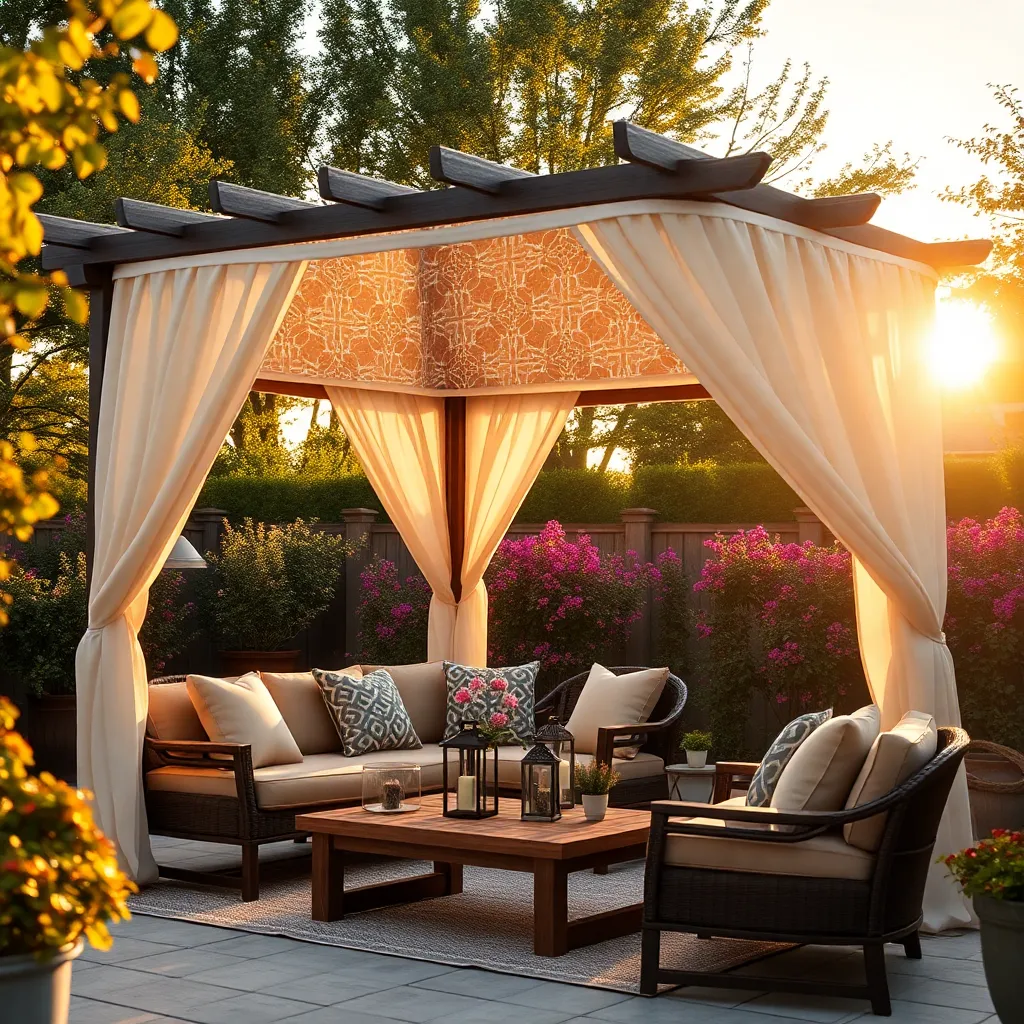
Adding a pop-up shelter tent to your outdoor space is a quick and flexible way to provide shade and comfort. These tents are ideal for homeowners who need a temporary or seasonal solution, as they can be easily set up and dismantled. Look for options with durable materials like polyester or canvas, which offer good weather resistance. Many models come with adjustable legs, allowing you to tailor the height based on your needs, and some even include sidewalls for added protection from the elements.
For those seeking advanced features, consider pop-up tents with UV protection and water-repellent coatings to extend their lifespan. Ensure the frame is made from robust materials such as aluminum or steel for enhanced stability. When choosing dimensions, measure your outdoor area to ensure the tent provides ample space for seating and movement. With various color and design options available, you can easily find a pop-up shelter that complements your existing outdoor aesthetic, making it both a practical and stylish addition.
Design a Covered Swing Area
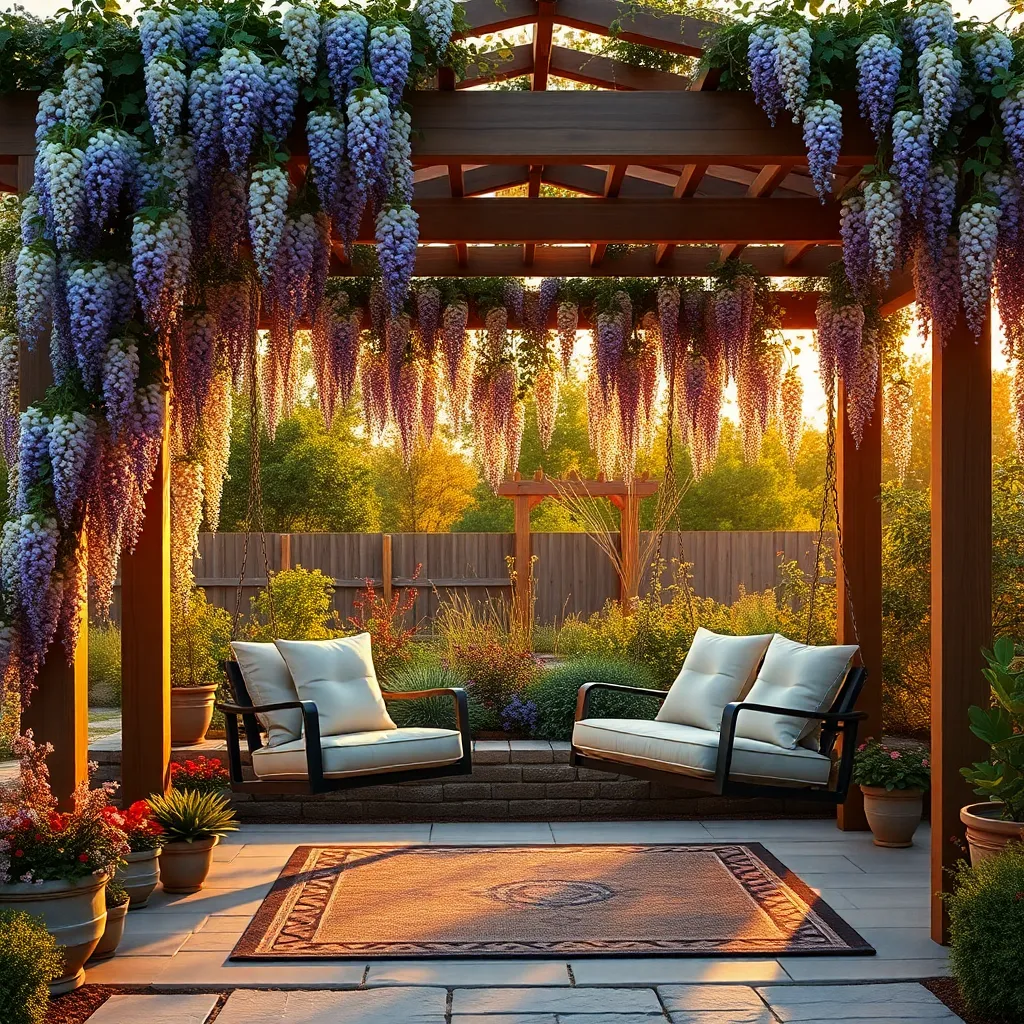
Creating a covered swing area in your garden can transform an unused space into a charming retreat. Start by selecting a durable, weather-resistant material like pressure-treated wood or metal for the swing frame to ensure longevity. Consider a canopy design using UV-protected fabric or corrugated polycarbonate panels, which offer excellent shade and rain protection. For beginners, pre-made swing kits are available and provide easy assembly with minimal tools, while more experienced DIYers might opt for custom-built frames tailored to their outdoor space.
Enhancing comfort and style, add cushions made from outdoor-grade fabric, which resist fading and mildew. To elevate your swing area, install solar-powered string lights above for an inviting glow in the evening. For a touch of nature, plant climbing vines such as clematis or wisteria to grow over the structure, offering both shade and a natural aesthetic. Keep dimensions in mind: a swing should have at least 3-4 feet of clearance on each side for safety and movement, ensuring a pleasant and relaxing experience for everyone.
Utilize Bamboo Screens for Shade
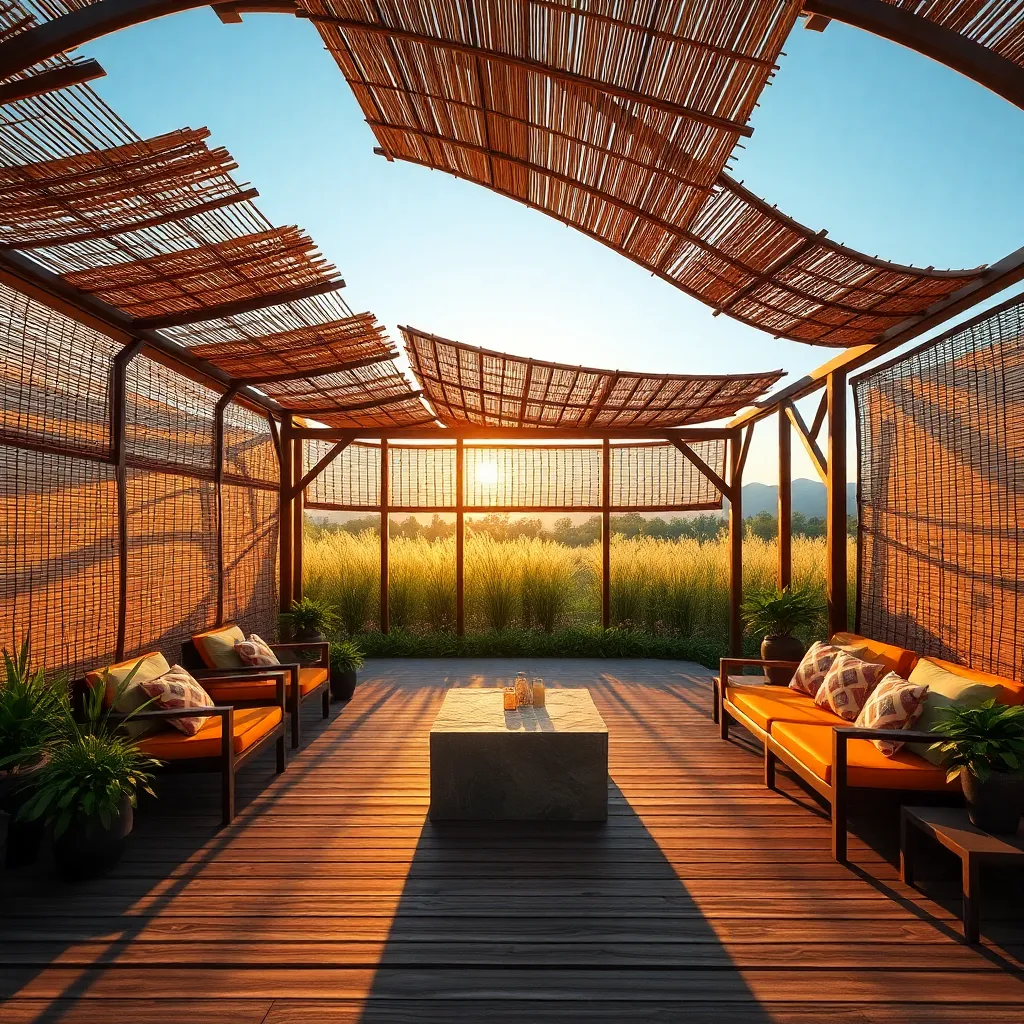
Integrating bamboo screens into your outdoor seating area is a smart way to create natural shade while adding an aesthetic touch. These screens are not only environmentally friendly but also easy to install, making them suitable for both beginners and seasoned DIY enthusiasts. For a simple yet effective setup, consider purchasing pre-made bamboo panels that can be attached to existing structures or standalone frames. Ensure the bamboo is treated for outdoor use to enhance its durability against weather conditions.
For those seeking a more advanced project, constructing a custom bamboo screen can offer a tailored fit for your space. Start by selecting high-quality bamboo poles, ideally around 1 to 2 inches in diameter, for sturdiness. Secure these poles vertically onto a wooden or metal frame using heavy-duty twine or zip ties for a rustic look. Adjust the spacing between poles to control the amount of light and airflow, providing a comfortable balance of shade and ventilation. This approach not only enhances the functionality of your outdoor area but also introduces a touch of elegance and privacy.
Conclusion: Creating Beautiful Outdoor Spaces
As we explored the ’13 Outdoor Seating Shelter Ideas for Comfort,’ each concept beautifully illustrated how creating a nurturing environment can enhance your relationship. From cozy pergolas to versatile gazebos, these shelters not only provide comfort but also foster meaningful connections by offering intimate spaces for conversations, relaxation, and shared experiences. Each idea serves as a metaphor for the importance of building a strong, protective space for love to flourish.
Now, take a moment to envision your own outdoor oasis. Choose one idea that resonates with you and plan a weekend project with your partner to bring it to life. This shared endeavor can be a delightful opportunity to bond, communicate, and strengthen your relationship.
Remember, a thriving relationship is cultivated with care, creativity, and commitment. Bookmark this article as your go-to guide for inspiration and practical tips, ensuring you always have a resource to revisit.
As you transform your outdoor spaces, look forward to a future where your relationship thrives amidst comfort and connection, proving that the right environment can be a cornerstone of enduring love. Take action today, and watch your relationship grow in warmth and joy.
